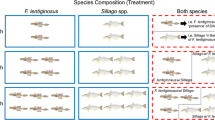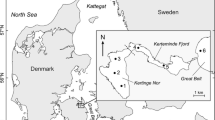Abstract
Jellyfish are ubiquitous predators in marine pelagic environments and can sometimes control their zooplankton prey populations. Recent considerations of the fertilization of entire food webs in coastal areas make it important to investigate the response of jellyfish to resource enrichment. We investigated feeding, assimilation and life history parameters in the hydromedusa species Sarsia gemmifera. S. gemmifera was able to ingest up to 3 µg carbon per hour, which corresponds to a daily carbon ingestion that exceeds the individual's body weight (carbon). Conversion of ingested carbon into tissue was less than 30%. The assimilated carbon was allocated such that approximately 65% was used for growth and the remainder for asexual reproduction. Carbon from food was allocated to asexually produced offspring within hours. The numerical response of S. gemmifera reached saturation at prey levels of 100 or more copepods per liter. Propagule quality was influenced by maternal effects: higher net production of the mothers in higher food environments resulted in higher carbon content of individual propagules. Starvation resistance of propagules was therefore positively related to food density in the maternal environment. The food concentrations which S. gemmifera normally experiences in the field are much lower than the food levels at which this species had its maximum asexual reproductive output in the laboratory. Therefore, S. gemmifera may potentially benefit from food web perturbations which increase crustacean zooplankton densities.






Similar content being viewed by others
References
Beklemishev CW (1962) Superfluous feeding of marine herbivorous zooplankton. Rapp P-v Reun Cons Perm Int Expl Mer 153:108–113
Conover RJ (1978) Transformation of organic matter. In: Kinne O (ed) Marine Ecology, vol 4. Wiley, New York, pp 221–499
Cosper TC, Reeve MR (1975) Digestive efficiency of the chaetognath Sagitta hispida Conant. J Exp Mar Biol Ecol 17:33–38
Costello JH (1988) Laboratory culture and feeding of the hydromedusa Cladonema californicum Hyman (Anthomedusa: Cladonemidae). J Exp Mar Biol Ecol 123:177–188
Costello JH, Colin SP (2002) Prey resource use by coexistent hydromedusae from Friday Harbor, Washington. Limnol Oceanogr 47:934–942
Daan R (1986) Food and growth of Sarsia tubulosa with quantitative estimates of predation on copepod populations. Neth J Sea Res 20:67–74
Eiane K, Aksnes DL, Bagoien E, Kaartvedt S (1999) Fish or jellies – a question of visibility? Limnol Oceanogr 44:1352–1357
Gismervik I, Olsen Y, Vadstein O (2002) Micro- and mesozooplankton response to enhanced nutrient input – a mesocosm study. Hydrobiologia 484:75–87
Hantzsche F (2002) Experimentelle Untersuchungen zum Einfluss von Rippenquallen auf marine Nahrungsnetze. MS thesis, University of Munich, Germany
Hirota J (1972) Laboratory culture and metabolism of the planktonic ctenophore Pleurobrachia bachei. In: Takenouti AY (ed) Biological oceanography of the North Pacific Ocean. Idemitsu Shoten, pp 465–484
Holling CS (1959) Some characteristics of simple types of predation and parasitism. Can Ent 91:385–398
Kremer P, Reeve MR (1989) Growth dynamics of a ctenophore (Mnemiopsis) in relation to variable food supply. II. Carbon budgets and growth model. J Plankton Res 11:553–574
Larson RJ (1987) Trophic ecology of planktonic gelatinous predators in Saanich Inlet, British Columbia: diets and prey selection. J Plankton Res 9:811–820
Legovic T (1987) A recent increase of jellyfish populations: a predatory–prey model and its implications. Ecol Model 38:243–256
Lindahl O, Hernroth L (1983) Phyto-zooplankton community in coastal waters of western Sweden: an ecosystem off balance? Mar Ecol Prog Ser 10:119–126
Martinussen MB, Bamstedt U (1999) Nutritional ecology of gelatinous planktonic predators. Digestion rates in relation to type and amount of prey. J Mar Biol Ecol 232:61–84
Matsakis S, Conover RJ (1991) Abundance and feeding of medusae and their potential impact as predators on other zooplankton in Bedford Basin (Nova Scotia, Canada) during spring. Can J Fish Aquat Sci 48:1419–1430
Mills CE (1995) Medusae, siphonophores, and ctenophores as planktivorous predators in changing global ecosystems. ICES J Mar Sci 52:575–581
Olesen NJ (1995) Clearance potential of jellyfish Aurelia aurita, and predation impact on zooplankton in a shallow cove. Mar Ecol Prog Ser 124:63–72
Purcell JE (1983) Digestion rates and assimilation efficiencies of siphonophores fed zooplankton prey. Mar Biol 46:65–81
Purcell JE (1990) Soft bodied zooplankton predators and competitors of larval herring (Clupea harengus pallasi) at herring spawning grounds in British Columbia. Can J Fish Aquat Sci 47:505–515
Purcell JE (1992) Effects of predation by the scyphomedusan Chrysaora quinquecirra on zooplankton populations in Chesapeake Bay. Mar Ecol Prog Ser 87:65–76
Purcell JE (1997) Pelagic cnidarians and ctenophores as predators: Selective predation, feeding rates, and effects on prey populations. Ann Inst Oceanogr 73:125–137
Purcell JE, Grover JJ (1990) Predation and food limitation as causes of mortality in larval herring at a spawning ground in British Columbia. Mar Ecol Prog Ser 129:63–70
Purcell JE, Sturdevant MV (2001) Prey selection and dietary overlap among zooplanktivorous jellyfish and juvenile fishes in Prince William Sound, Alaska. Mar Ecol Prog Ser 210:67–83
Purcell JE, Silferd TD, Marliave JB (1987) Vulnerabilityof larval herring (Clupea harengus pallasi) to capture by the jellyfish Aequorea victoria. Mar Biol 94:157–162
Purcell JE, Bamstedt U, Bamstedt A (1999) Prey, feeding rates, and asexual reproduction rates of the introduced oligohaline hydrozoan Moerisia lyonsi. Mar Biol 134:317–325
Reeve MR, Syms MA, Kremer P (1989) Growth dynamics of a ctenophore (Mnemiopsis) in relation to variable food supply. I. Carbon biomass, feeding, egg production, growth and assimilation efficiency. J Plankton Res 11:535–552
Sakshaug E, Olsen Y, Hoell E (1995) Maricult research programme: fertilising marine ecosystems to harvest more. ICES CM 1995/T:1
Salvesen I, Skjermo J, Vadstein O (1999) Growth of turbot (Scophthalmus maximus L) during first feeding in relation to the proportion of r/K strategists in the bacterial community of the rearing water. Aquaculture 175:337–350
Smayda JT (1997) Harmful algal blooms: their ecophysiology and general relevance to phytoplankton blooms in the sea. Limnol Oceanogr 45:1137–1153
Suchmann CL, Sullivan K (2000) Effect of prey size on vulnerability of copepods to predation by the scyphomedusae Aurelia aurita and Cyanea sp. J Plankton Res 22:2289–2306
Toonen RH, Chia FS (1993) Limitations of laboratory assessments of coelenterate predation: container effects on the prey selection of the limnomedusa Proboscidactyla flavicirrata (Brandt). J Exp Mar Biol Ecol 167:215–235
Valiela I (1991) Ecology of water columns. In: Barnes RS, Mann KH (eds) Fundamentals of aquatic ecology. Blackwell, Oxford pp 29–56
Verity PG, Smetacek V (1996) Organism life cycles, predation, and the structure of marine pelagic ecosystems. Mar Ecol Prog Ser 130:277–293
Acknowledgments
We thank T Hansen and Y Olsen for technical support, S Diehl, A Sell, and U Sommer for helpful comments on the manuscript. The research has been supported by the EU project COMWEB (MAS3-CT96-0052) and by the Improving Human Potential-Transnational Access to Research Infrastructures Programme of the European Commission (Trondheim R.I.).
Author information
Authors and Affiliations
Corresponding author
Rights and permissions
About this article
Cite this article
Stibor, H., Tokle, N. Feeding and asexual reproduction of the jellyfish Sarsia gemmifera in response to resource enrichment. Oecologia 135, 202–208 (2003). https://doi.org/10.1007/s00442-003-1189-4
Received:
Accepted:
Published:
Issue Date:
DOI: https://doi.org/10.1007/s00442-003-1189-4




